Last Updated on: 16th November 2022, 09:12 pm
Food choices on the Everest Base Camp Trek include pasta, noodles, soups, omelets, fried eggs, pancakes, potatoes, momos, pizza, and the traditional Nepali dish, Dal Bhat, which includes lentil soup, boiled rice, vegetable curry, Nepali bread and pickle. Most tea house menus are similar, the main difference being in their prices that go up with altitude.
In this Everest Base Camp Trek food guide I’ll show you the different foods available in tea houses, the best meal planning tips, the foods to try and the foods to stay away from. You’ll learn about the main dishes and the best time of day to have them. You can also check out the other articles in this series, What to pack for Everest Base Camp trek, EBC Trek overview, and EBC trek FAQ.
If you like rice and you don’t mind eating the same thing several days in a row, you won’t suffer on the Everest Base Camp trek. If you want variation, you’ll miss your raw fruit, greens, vegetables and meat. You won’t find raw foods above Namche Bazar. Apparently, one of the reasons is the lack of reliable water sources to wash these foods. There is meat, but most trekkers prefer to stay away from it, the reason being the lack of proper storage and transportation conditions. A steak that has traveled several days on the back of a yak, horse or donkey may not be the wisest food choice, particularly when you come from a culture with high hygiene standards.
Main Topics of Everest Base Camp Trek Food Guide
Everest Base Camp Trek Food – Meals, Logistics, Tips & Tricks
Everest Base Camp is one of the most popular treks worldwide. Also, the season is rather short (from late February to mid-May, and from late September to December). This means the trail will be busy, with human and animal traffic jams in its most sketchy parts.
Eat Like Nepali People
Long before reaching Nepal, I had my mind set on eating like the local people. I was certain that their meals frequency and food choices were the result of the trial and error processes of many generations. I had to break all my eating rules and to give up my eating habits to ensure I was going to reach my goal.
To start with, I seldom eat before noon. On the Everest Base Camp trek I had to start each day with a generous breakfast to keep me going for several hours.
Another rule I never break at home is to eat only three times a day, maximum. On the mountain, though, when you feel depleted of vital energy, a simple chocolate or a snack bar can give you a nice boost. Fortunately, I took some snacks in my backpack, even though I didn’t believe I was going to touch them.
I don’t eat deep fried stuff, because I believe it is bad for me. On the Everest Base Camp trek, as well as in Kathmandu for that matter, I couldn’t care less about the cooking methods.
The first rule of the EBC Trek is that you don’t walk to eat but rather eat to keep going. This trek isn’t a culinary experience. It is a military routine. it is applied discipline. Fortunately it unfolds in a gorgeous scenery, otherwise way fewer people would do it.
The second rule is that you must force yourself to shove food down your throat three times a day even if you don’t feel hungry. Appetite loss is one of the altitude sickness symptoms, so you should be wary of it at all times. This was not my case. I ate like a starving wolf even at altitudes above 4000m. I guess I was a fortunate exception, though.
Order Breakfast the Evening Before
As most trekkers follow the official EBC trek guides, they stop in the same villages, and almost at the same time. The result is that most tea houses will be also full of people. These guests want to eat as soon as they get there. Also, they all want to start their next day of trekking by the same time, so they need to have breakfast at the same time. This puts tremendous pressure on the tea house staff.
The solution is to order your breakfast the evening, just before you go to bed, in order to have it ready by the time you get out of bed the next morning. It will only come as a surprise the first time!
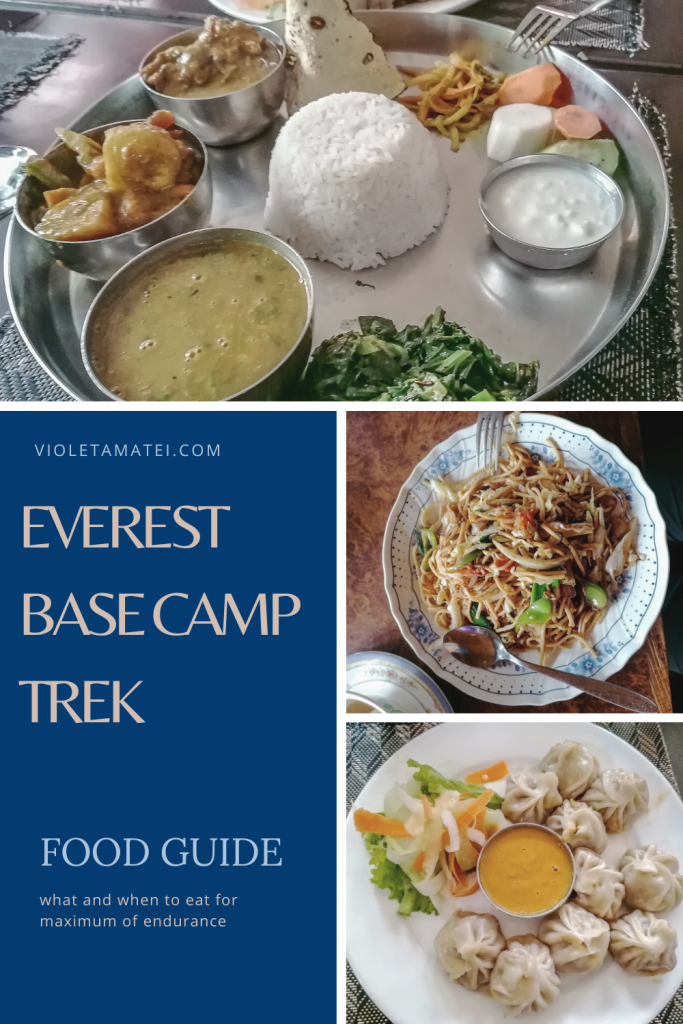
Save this Everest Base Camp Trek Food Guide to Pinterest for later
This is where a guide comes in handy. Guides are the ones that bring you the menus, collect your orders, pass them on to the kitchen staff, and bring the food to your table. They also clean the table afterwards. In fact, your guide on the trek is your waiter at lunch places and tea houses. Sometimes, guides have to fight with their peers to ensure you get your food as quickly as possible.
You can trek to Everest Base Camp on your own, without a guide, but you’d miss on their helpful advice and on the great opportunity to interact with a local for 16 days. The trek isn’t always strenuous, so you’ll have lots of moments when you’ll be able to sustain a conversation while walking. You can create connections that last.
In one of those tea houses, our guide, Santa, encountered a guy who has been his client for several times. They knew each other for 10 years or so!
Dal Bhat (Dal Bhat Tarkari or Nepali Set)
Dal Bhat (or Dahl Bhat Tarkari, or Nepali Set) is the traditional Nepali dish. It consists from boiled rice, lentil soup, Nepali bread and several side dishes such as vegetable curry, boiled vegetables, and pickle. You’ll find Dal Bhat everywhere in Nepal, from Kathmandu to Lukla, Namche Bazaar, Gorak Shep, and Gokyo. All porters and guides eat it, sometimes even twice a day. The recipe differs from one place to the next. I’m sure that tea house cooks and managers adapt it to use whatever foods they have available. The only things that don’t change are the rice and the lentils.
Each tea house has its own Dal Bhat version. Sometimes the dish is spicy. Other times it is bland. Sometimes it comes with nice pickles, other times with a dollop of red, hot chili paste. Should you like your food hot, you’ll find small dried chili peppers or hot chili powder in all tea houses and restaurants along the trek.
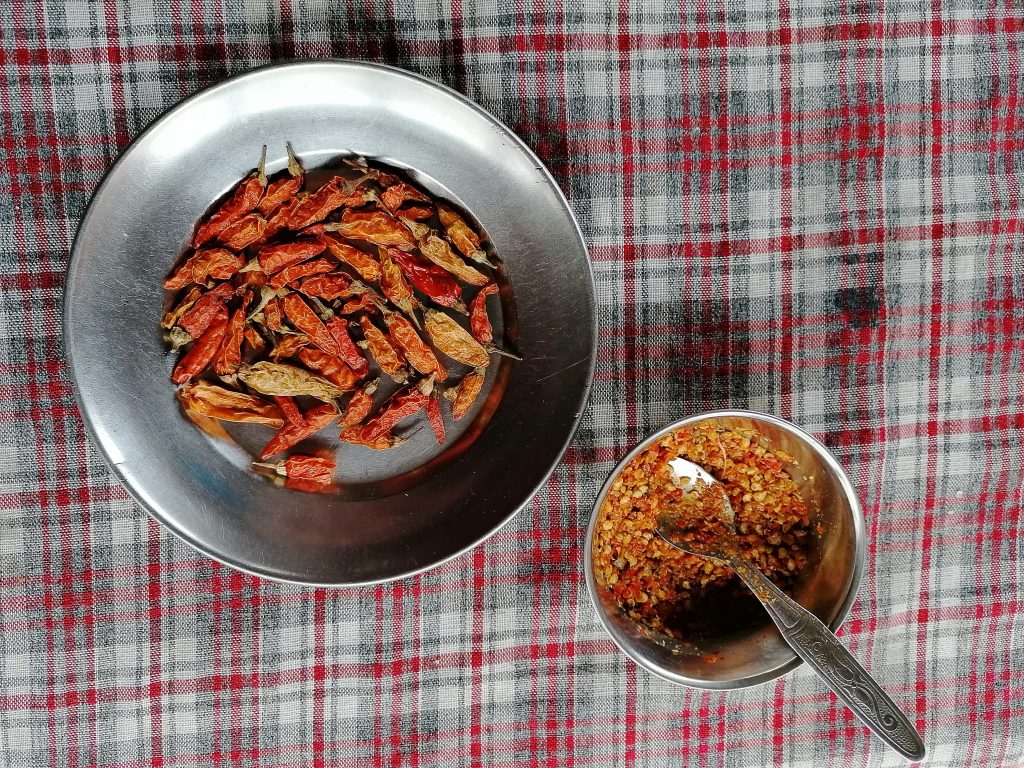
Red dried chili peppers and hot chili powder in Pangboche, one of the places we stopped for lunch
Dal Bhat has quickly become my top choice of food on the Everest Base Camp Trek for multiple reasons:
- Lentils and rice that make the bulk of the Dal Bhat dish are tasty and nutritious
- You get a set of multiple mini-dishes for the price of one – mixing and matching foods is one of my favorite things to do
- You get a free second refill on lentils and rice (and sometimes on curry, as well). As opposed to the majority of EBC trekkers, I had a HUGE appetite, even at high altitudes
- It takes less time to prepare than other choices (such as momos, which seem to take forever)
- “Dal Bhat power 24 hour” – any guide on the Everest Base Camp trek will tell you that (some admit, though, that the real power of a dal bhat is only 6 hours, not 24)
Here are some of the Dal Bhat dishes I ate during my Everest Base Camp trek in May 2022.
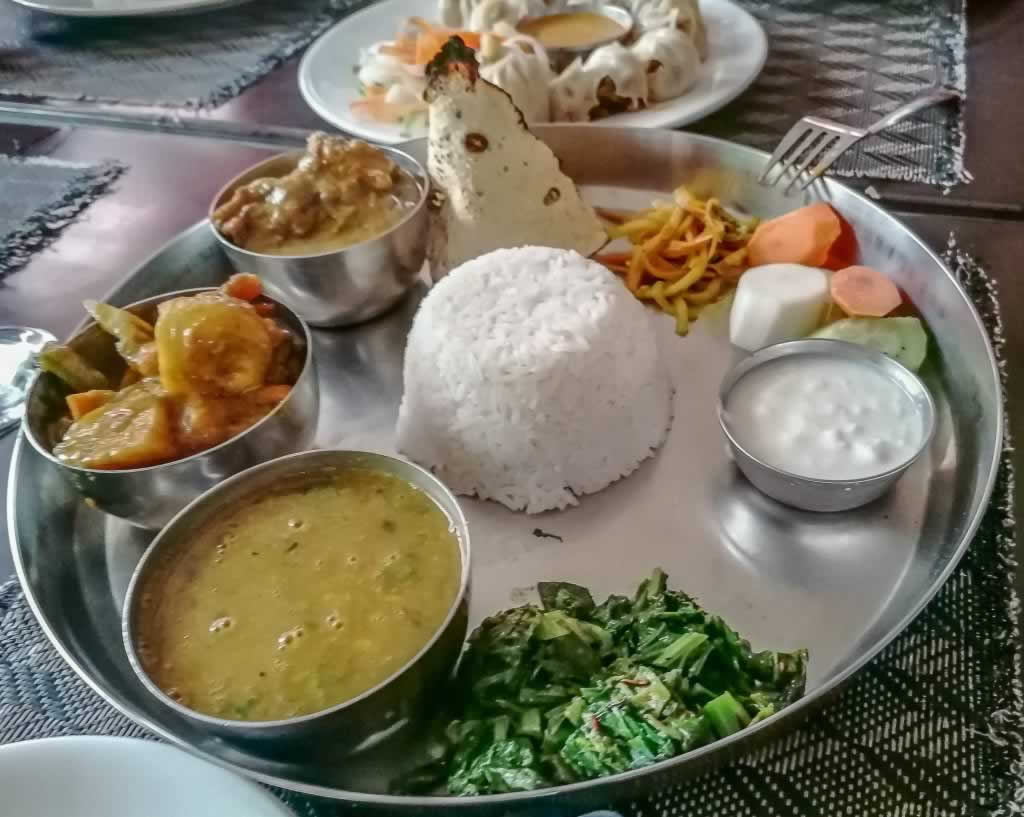
My first Dal Bhat – I ordered this in Kathmandu, the day before we started the trek – I had no idea it was going to be the first in a long series of dal bhats
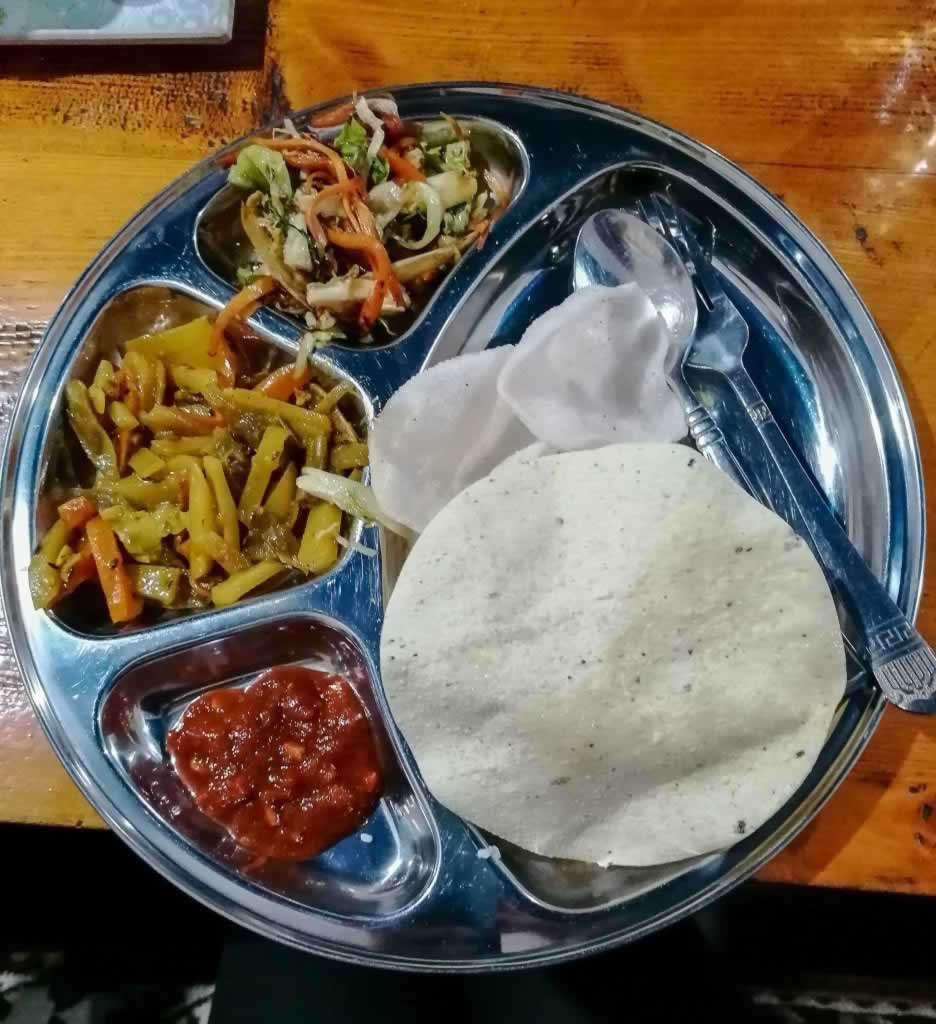
The Dal Bhat in Gorak Shep contained something special: prawn crackers – we used to eat lots of those in our childhood – the lentil soup was also there, but I forgot to take a photo of it
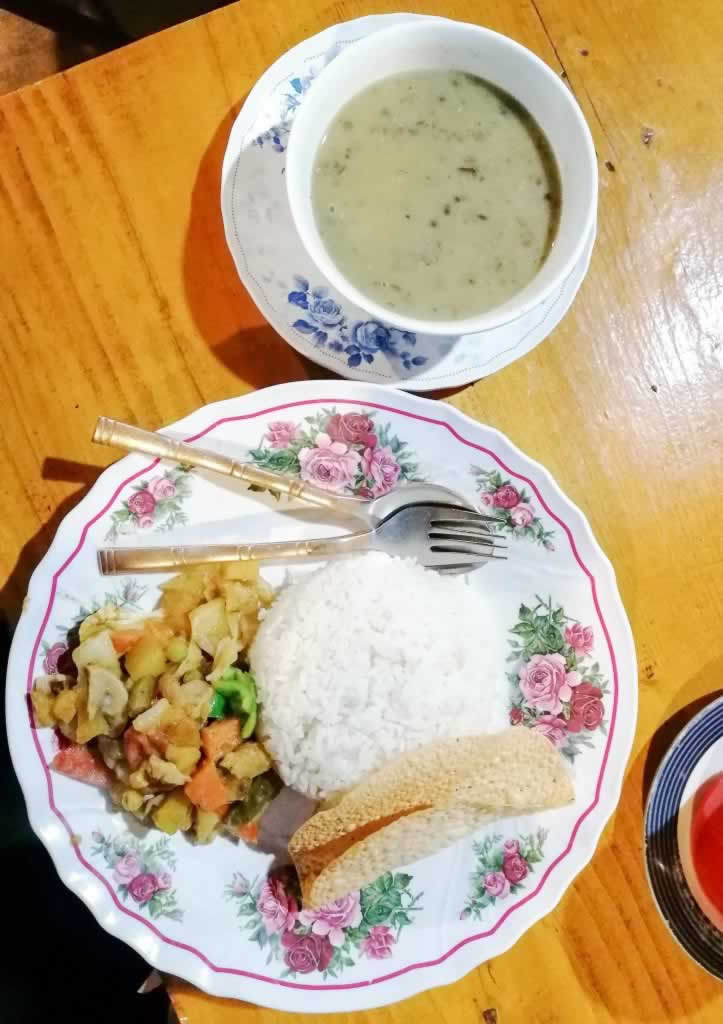
The Dal Bhat in Dzongla (Maison Sherpa) was tasty and nicely presented, even though it didn’t contain pickle or hot sauce
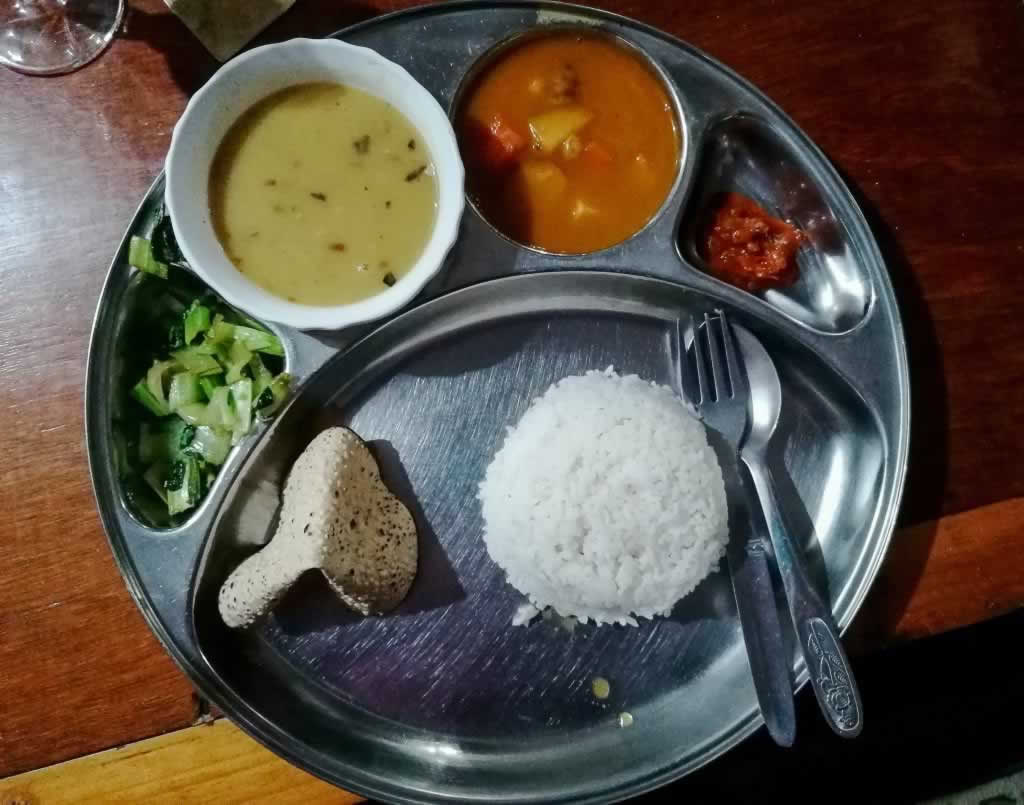
Dal Bhat in Tengboche – the higher you get, the smaller the Nepali bread – how I loved those free rice and lentil refills!
I’m sure there were more of them, but these are the only photos I’ve found. Sometimes I was too hungry or too tired to take photos of my food.
Nepali Momo (Nepalese Dumplings)
I love dumplings, so there’s no wonder I had to try the Nepali Momo dish as soon as I got to sit in a Nepalese restaurant. The filling can be meat or vegetables. There are buffalo momo, chicken momo, vegetable momo, vegetable tuna momo, vegetable cheese momo, potato cheese momo, and mixed momos.
They are all as tasty as can be, because they aren’t pre-cooked in any way. The cook makes them on the spot. I saw him rolling and stuffing the dough, and then filling it with minced meat!
The downside, though, is that you need to wait for a very long time to get your food. That’s why I only ate momos twice during my trip to Nepal.
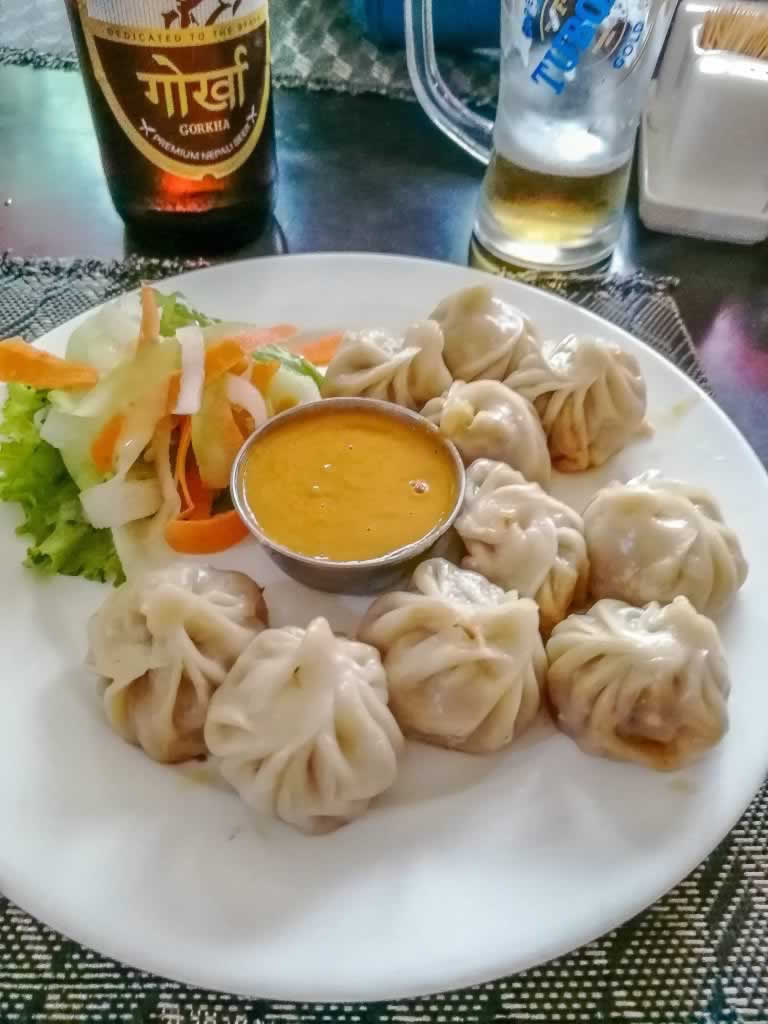
Look at these buffalo momos and tell me you don’t want to dip one in that spicy sauce right now! My mouth is watering as I write this.
I ate those buffalo momos in Kathmandu. The second time I had momos, they were vegetarian, because we were at an altitude of 4000m or so, where you are supposed to stay away from meat, in order to lower the risk of food poisoning. I still remember how everybody in our group had their foods, we were already full of tea and sleepy, when I made an inquiry about my momo order – I was sure the people in the kitchen had forgotten. Much to my surprise, they were still in the making and they arrived about 30 minutes later. There’s no wonder I forgot to take a photo!
Momos can be steamed or fried. I only tasted the steamed version, but I’m sure the fried ones must have been good, as well.
Noodles (Real Noodles, Korean Ramen, Rara Noodles, etc)
Noodles are very popular on the Everest Base Camp Trek.While some tea houses serve the real thing (noodles with real vegetables, cooked together with real spices), others rely on those cheap packs of dried noodles with dehydrated spicy stuff that swells and softens when it meets hot water.
These noodles only need a few minutes of boiling, so there’s no wonder all tea houses sell them and all trekkers buy them. Believe it or not, you can even eat them directly from the pack, not cooked at all. Our guide, Santa, was munching on Rara noodles on the trek. Real noodles take longer to cook, but they are still faster than momos. Besides, when mixed with fresh vegetables, noodles on the EBC trek are much better.
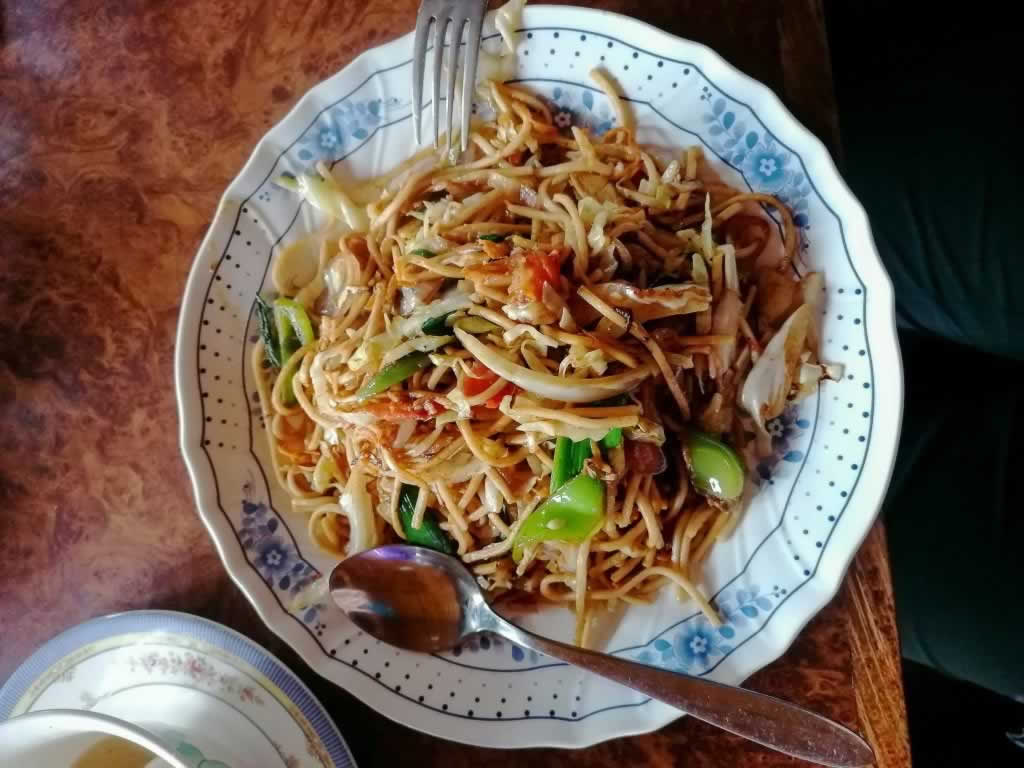
These noodles with vegetables in Lukla were the best of the entire trek (as voted by our group)
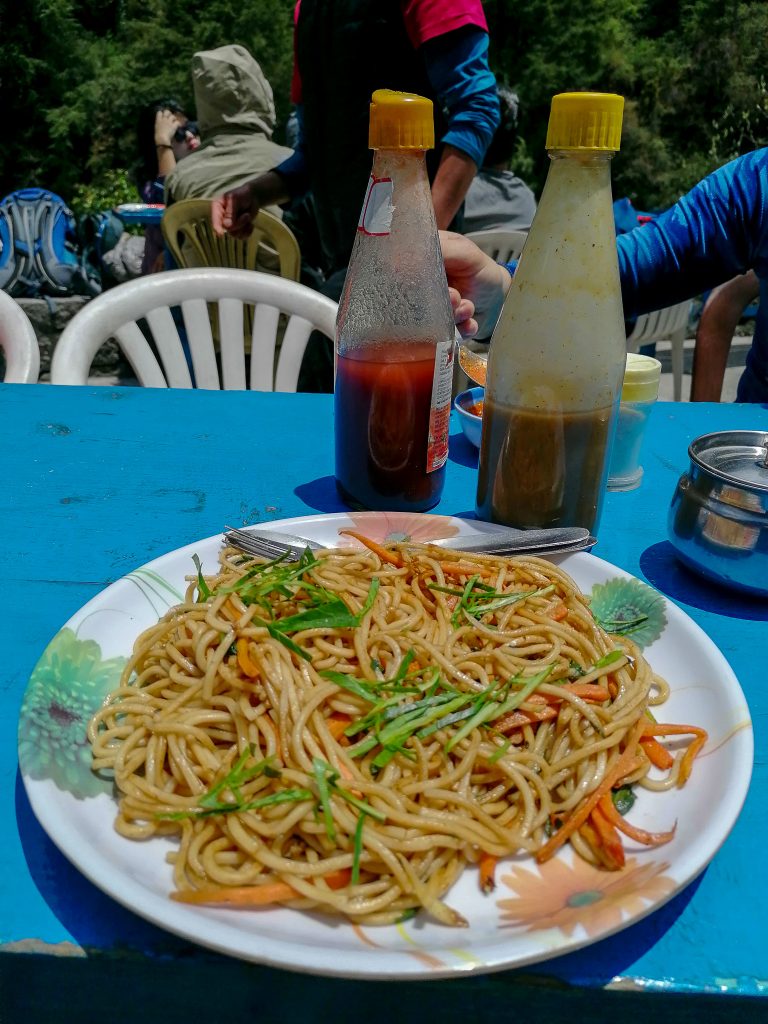
Another vegetable noodles recipe, not as good as the one in Lukla
Sherpa Stew
The Sherpa Stew is a thick soup with plenty of vegetables, greens and noodles. It is a good choice when you’re too hungry to eat only a soup but not hungry enough for a Dal Bhat or a more filling dish.
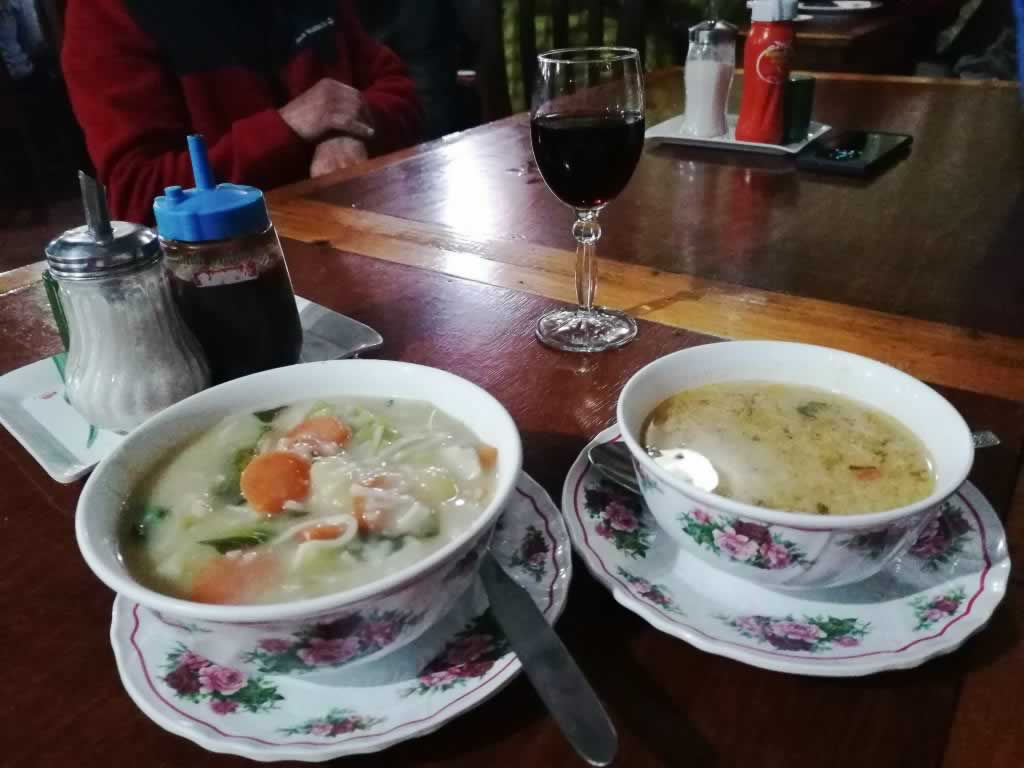
Sherpa Stew and egg drop soup on EBC Trek
Garlic Soup
According to locals, garlic helps the body to get accustomed with high altitudes. This would have been enough to persuade us eat huge amounts of garlic soup. In addition, we are Romanians and we do love our garlic! I think I ate at least 15 garlic soups on the Everest Base Camp Trek. The best, though, was the first one, the one we had in Lukla, just before starting our trek.
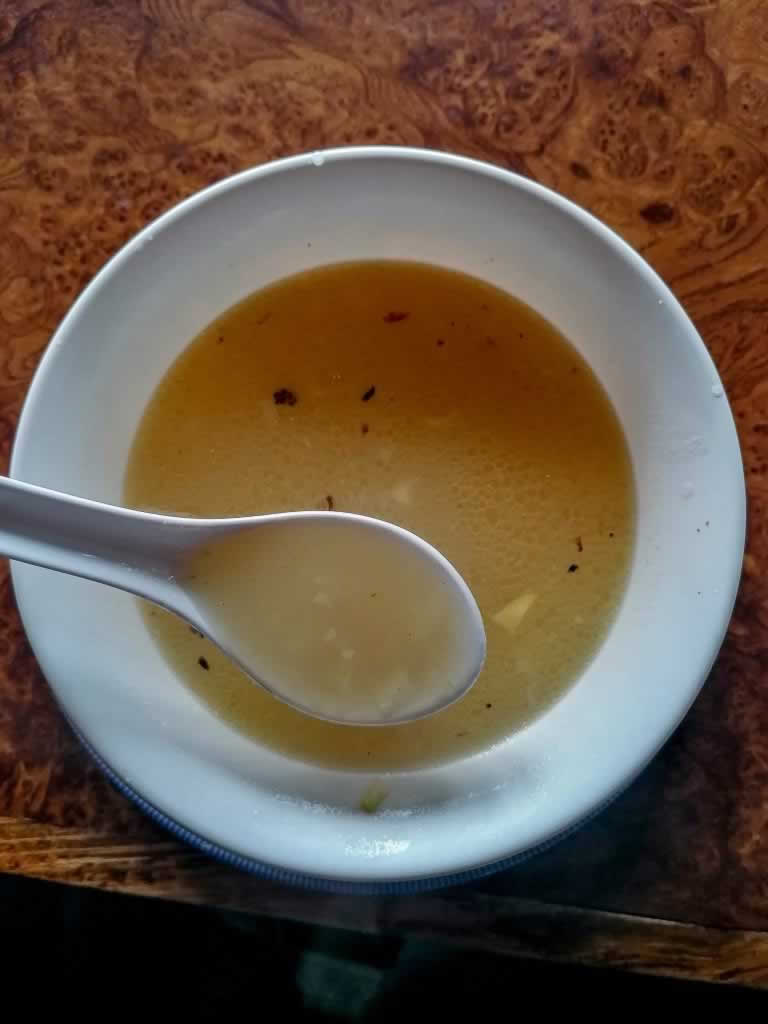
The garlic soup in Lukla, helping us fight the effects of high altitude
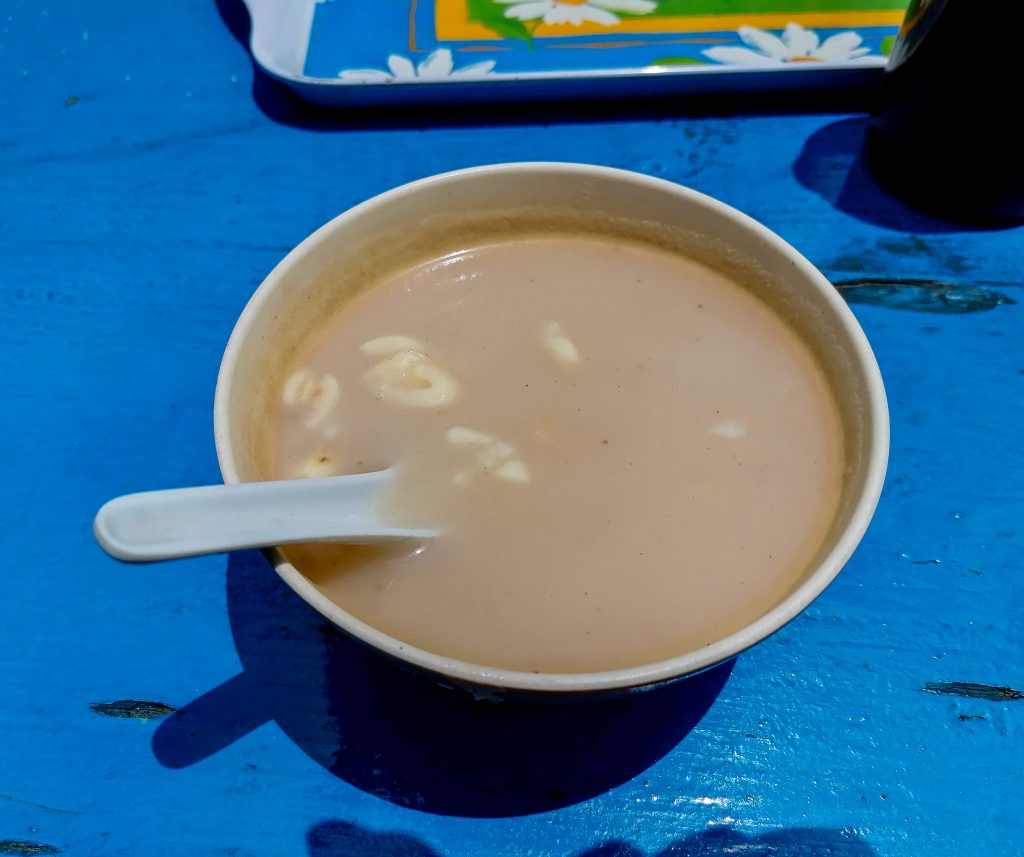
Just another garlic soup on the Everest Base Camp Trek – at the lunch break in Jorsalle – the one in Lukla was better
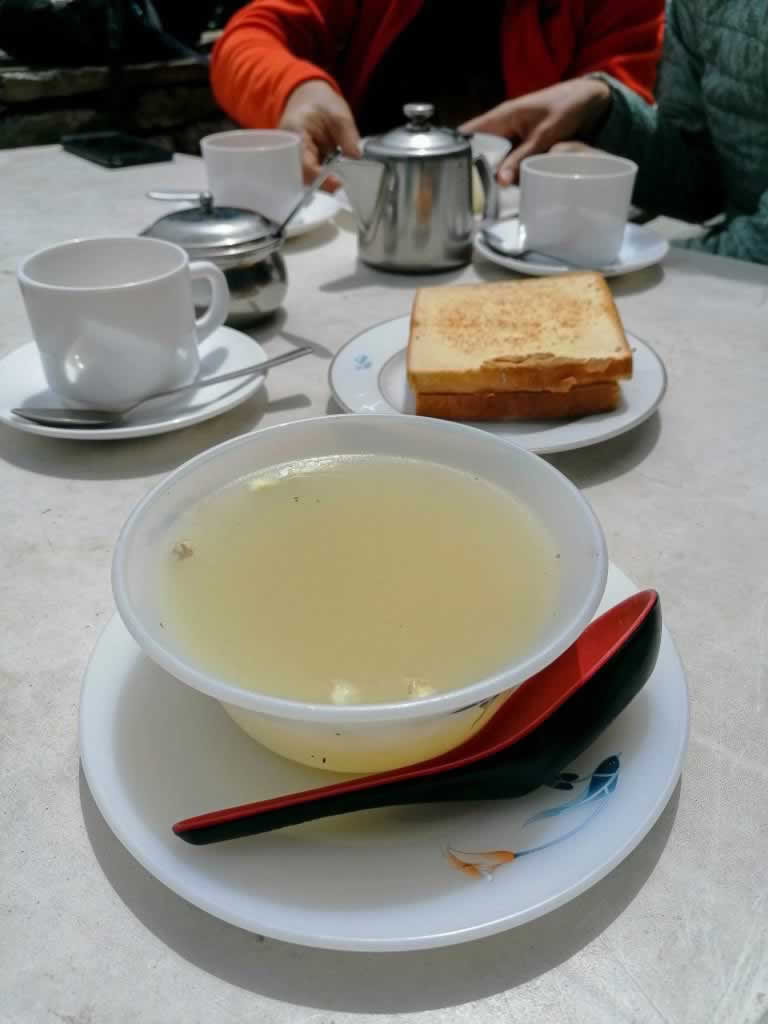
Others had tea breaks on the trek – more often than not, I opted for a nice bowl of garlic soup – I think I had this one at Everest View Hotel, in our acclimatization day in Namche Bazar
Other Soups
The soup menu was usually very generous. It included a variety of options such as potato soup, dal soup, garlic soup, onion soup, tomato soup, mushroom soup, vegetable soup, chicken soup, and egg drop soup.
Many of these are made from instant soups. Don’t expect to find real chicken meat in a “chicken soup.” As a general rule, don’t expect a certain dish to be the same across all of the tea houses and lunch places.
Potatoes
You can have potatoes in many forms on the Everest Base Camp Trek.
The cheapest ones are boiled potatoes, plain mashed potatoes and plain hash browns. Prices go up as you upgrade to hash brown or other potato dish with fried or boiled egg, cheese or vegetables.
You can also have potatoes as side dish to a steak, should you decide to overlook the advice of not eating meat on the trek.
I usually had hash browns for either breakfast or dinner.
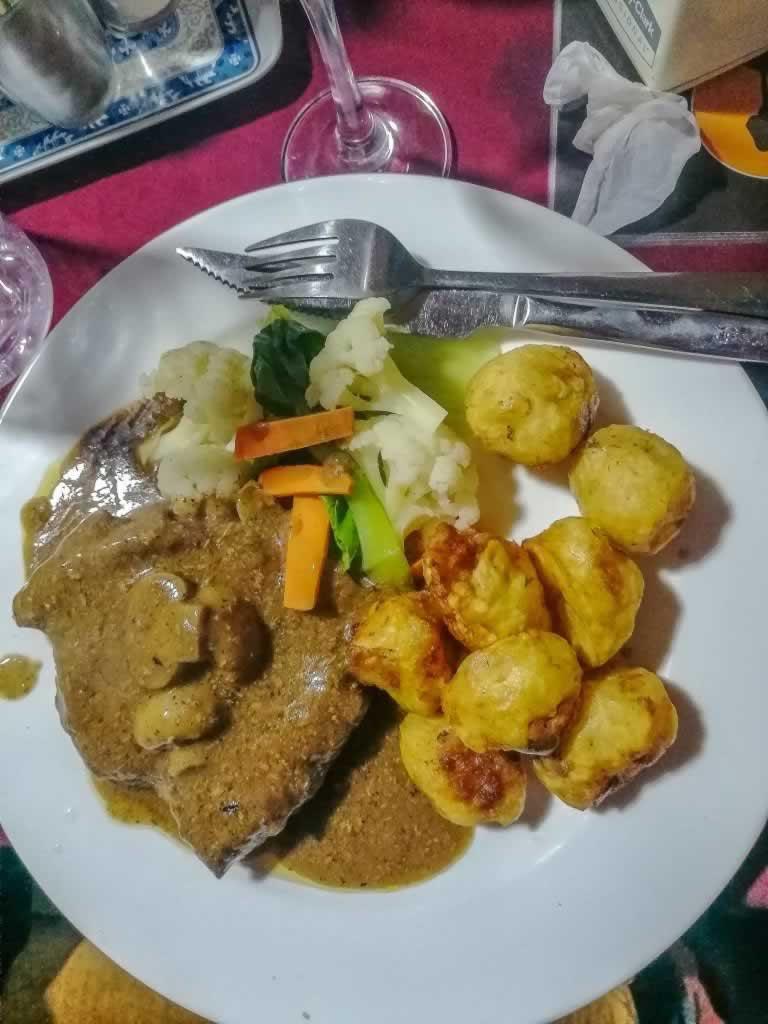
Yak steak with fried potatoes in Namche Bazaar, at Thawa Lodge & Bakery Cafe
The yak steak in the above photo is the only meat I ate on the entire EBC trek. It was in Namche Bazar, after we got back from the mountain. That’s also when I had alcohol for the first time since Kathmandu.
Bread
There are several types of bread you can get in the tea houses along the Everest Base Camp Trek.
The most boring one is the toast – those square and thin white bread slices you get for breakfast in most hotels. I had that for breakfast with fried eggs or omelet on top. Beware, though, at high altitude the two toast slices cost as much as the omelet or the fried eggs on top. You’ll find the same white bread in sandwiches with egg, tuna, vegetables or cheese.
Tibetan bread – this is a flat doughnut deep fried in oil. You can eat it with jam or chocolate for breakfast (you may find jam in some tea houses, but you may need to bring your own chocolate, as I didn’t spot any).
Nepali flat bread (roti) – unleavened bread made from wheat flour
Papad – a very thin, crispy wafer that comes as accompaniment with Dal Bhat. It has almost the same texture as the Chinese fortune cookies. In some tea houses it has its own position in the menu, while in others you only discover it on your Dal Bhat platter.
Just take a look at the above photos of Dal Bhat and you’ll see several types of bread you can find on the Everest Base Camp Trek.
Eggs
Eggs will provide you with the energy you’ll need to walk through your mornings. Most of the mornings two fried eggs or an omelet were enough to keep me in shape until noon. Adding toast was even better, until I found out that in Gorak Shep and in other high altitude villages two thin slices of toast had the same price as the two eggs.
You’ll find boiled eggs, fried eggs and various omelets at all tea houses along the trek. If that’s your favorite breakfast, you’re going to be happy.
Vegans and people with dietary restrictions will also find things to eat for breakfast. There are breads, pancakes, jam, butter, porridge, muesli, cornflakes, milk and puddings.
Cheese
If you love your cheese, you’ll miss it. There’s no cheddar on the Everest Base Camp trek. There’s only nak cheese, and even that is scarce. Nak is the female yak. Nak cheese is good, but I never had enough of it on my pasta or on my eggs to feel its taste.
Tea & Coffee
According to locals, ginger tea is very good for you, as it helps your acclimatization and counteracts the effects of altitude on your body.
That’s everything I needed to hear to fill myself with generous amounts of ginger tea at each and every stop along the trail.
In fact, all tea choices are based on black tea with different flavors such as ginger, lemon, and mint. Even when it contains pieces of real ginger or real mint leaves, the drink is still made from black tea.
I had coffee only once. It was worse than the worst breakfast coffee in Europe. If you need coffee to wake up, bring some with you. All tea houses sell hot water, so you can make your own coffee or tea. I was glad I had some green tea packs from home, for a change.
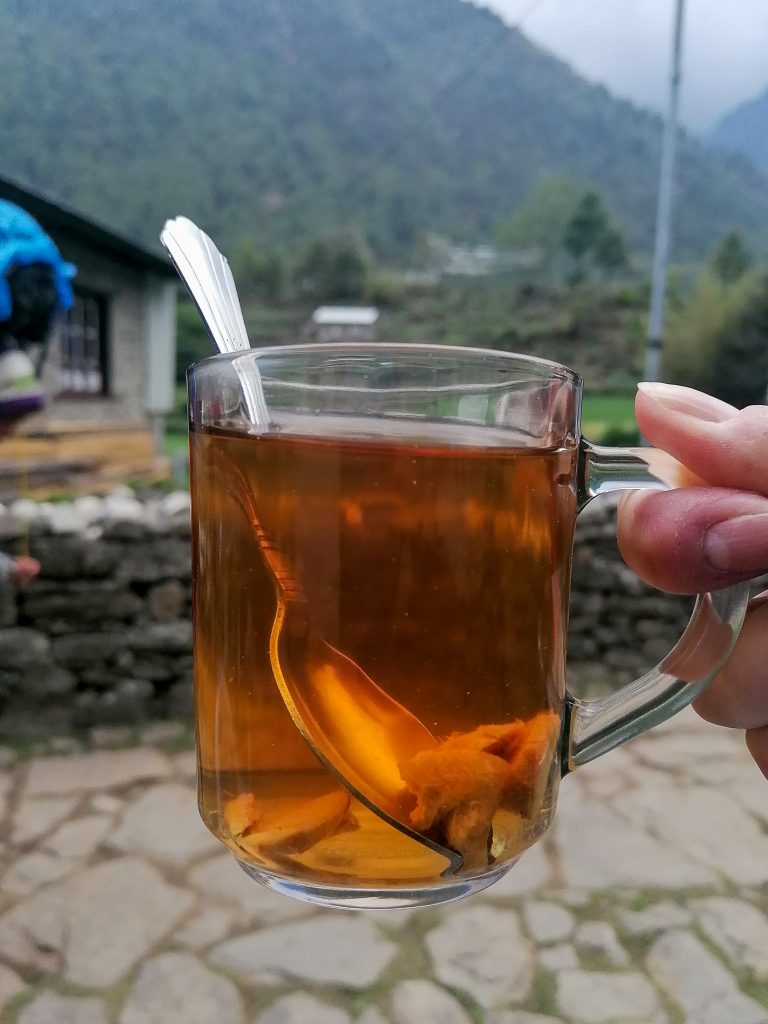
Ginger tea with fresh ginger – nice, spicy flavor
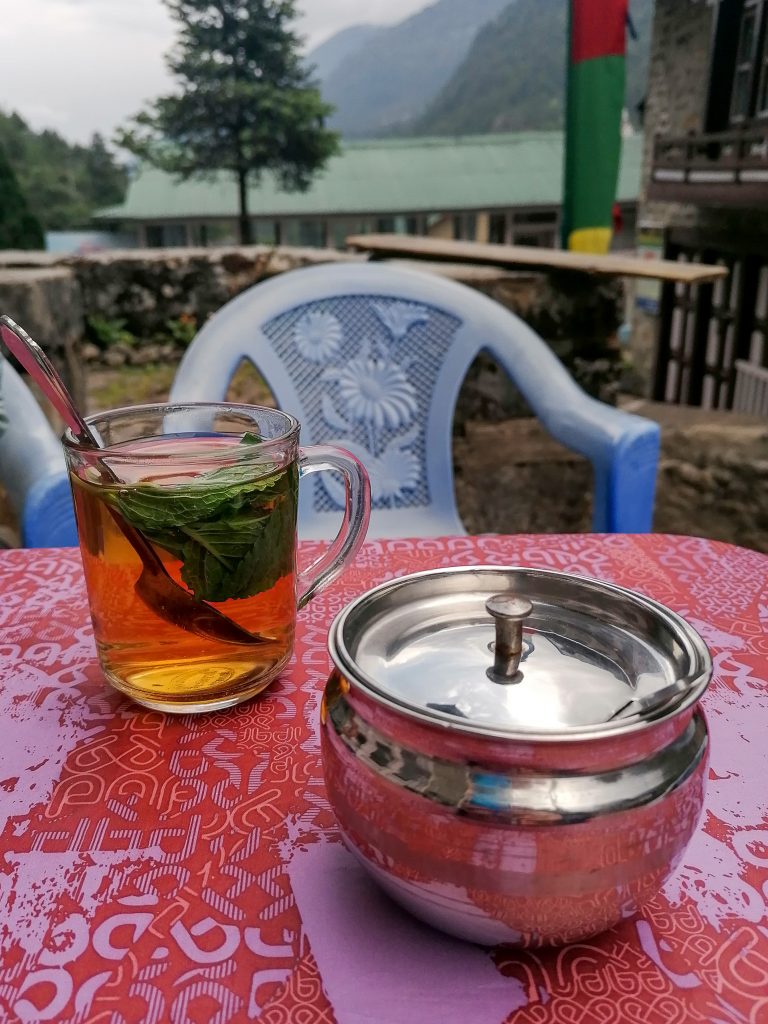
Mint tea with fresh mint (made from black tea, like all other tea variants)
Desserts
I only have three words to tell you: forget about them.
Apple pie is something that looks and feels like a brownie but tastes like apples (sort of, anyway). I tasted it twice: once in a tea house and once in the nice cafe in Dingboche which you’re going to visit by all means (because Dingboche is where you’ll spend a day of acclimatization).
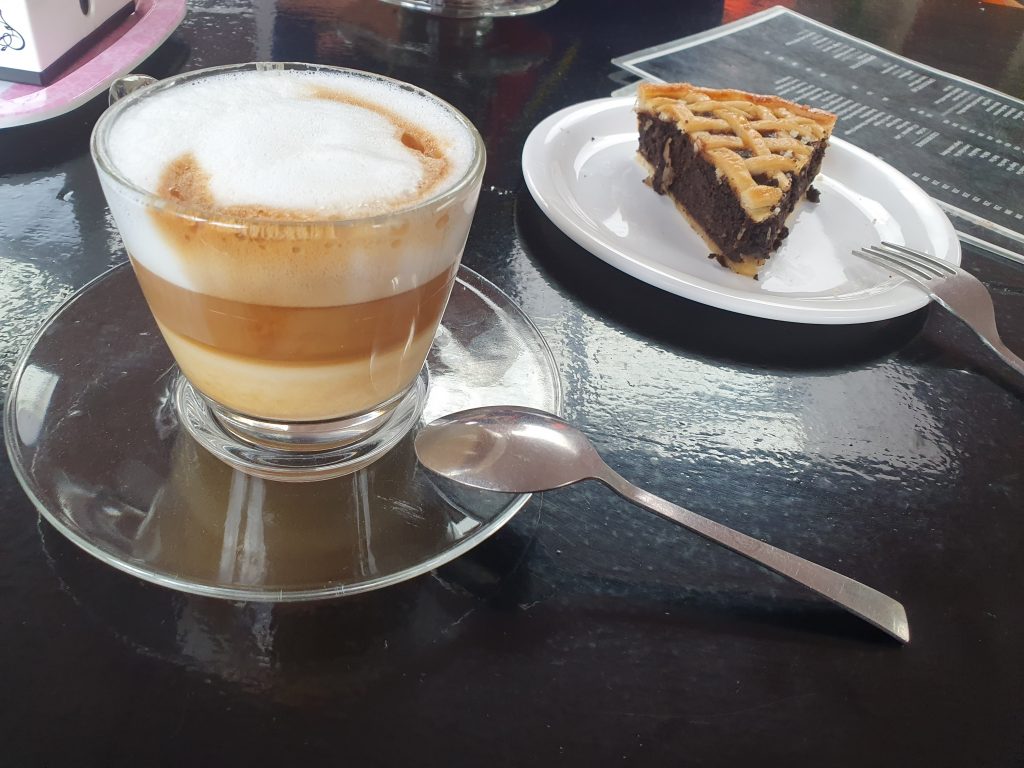
Apple pie and flat white in Dingboche
The flat white was good. It’s nice to have a real coffee after so many days of tea and electrolyte drinks.
I hope this Everest Base Camp trek food guide helps you plan your supplies and set your expectations to a reasonable level.
- Ramla Beach Gozo, Maybe the Best in Malta - April 9, 2024
- Where To Go on Honeymoon: List of the Most Interesting Countries - April 9, 2024
- A Guide to Nepal Treks from India - April 5, 2024

